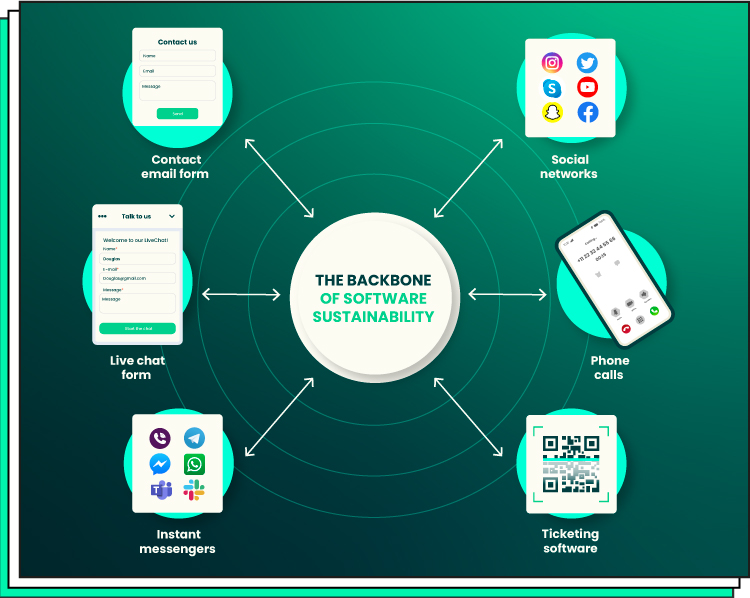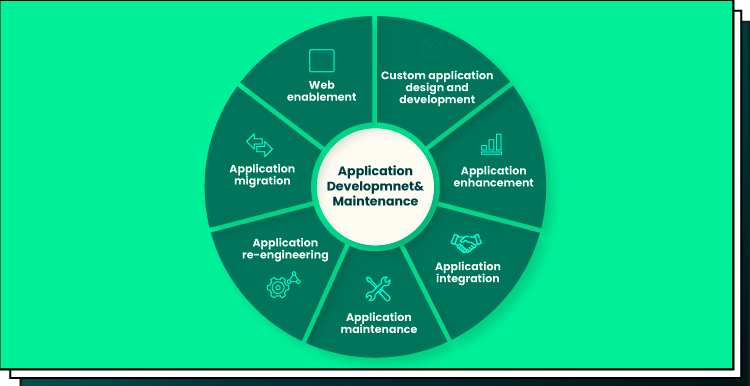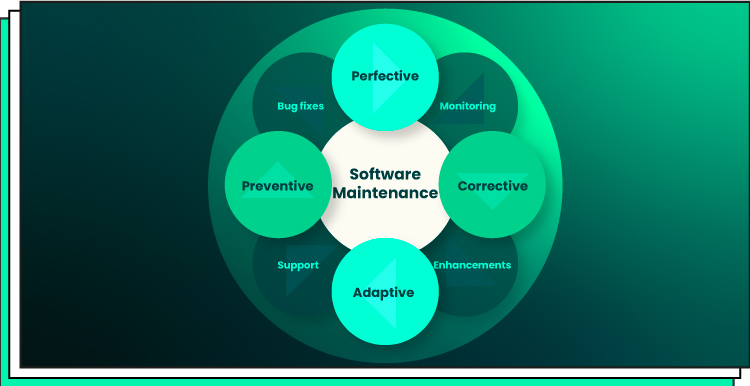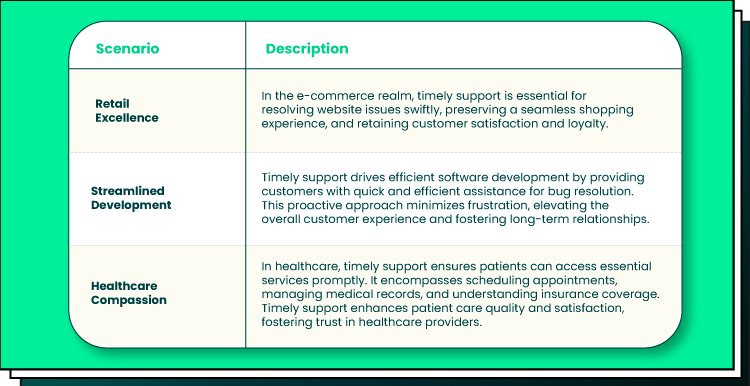Software applications have become integral to both our personal and professional lives. Whether it’s the app you use to manage your finances, connect with friends, or streamline your business operations, the performance and reliability of these applications are paramount. This is where application support and maintenance services come into play, ensuring that your software remains robust, secure, and user-friendly throughout its lifecycle.
If you are interested in keeping your applications efficient, we recommend that you adopt our IT consulting services and get immediate advice from experienced IT engineers skilled in application support. You may also consider hiring our dedicated teams for the development, testing, and support of your software to keep your project costs affordable. Before you decide, let’s learn more about the importance of application maintenance and support services.
The Backbone of Software Sustainability
Application support is a critical service encompassing both internal and external users, ensuring seamless digital operations. It falls into two main categories: technical and human support. Technical support maintains digital assets like web and mobile apps, websites, and software, addressing issues and enhancing user experience. Human support, often underestimated, aids end-users in understanding and navigating the software, reducing frustration and preventing user abandonment. Both aspects are vital for sustaining a thriving digital ecosystem and retaining users.
Consider the following application support channels, each tailored to meet various customer needs. A comprehensive application support model should cater to a diverse range of preferences:
- Contact email form. An ideal option for users seeking to submit app support requests or inquire about specific application details. It offers a structured and convenient way to communicate with the application support service team.
- Live chat. When immediate responses are essential, a live chat feature proves highly effective. It addresses issues swiftly and is particularly valuable for time-sensitive inquiries.
- Instant messengers. Many customers prefer instant messengers as a convenient means to reach the application support help desk. These platforms offer real-time communication for quick problem resolution.
- Social networks. Leveraging social networks provides users with rapid access to support services. It serves as a convenient channel for reaching out and receiving timely assistance.
- Phone calls. Despite its traditional nature, phone application support service remains a reliable solution, especially in emergencies. It ensures rapid assistance and direct communication when using the application.
- Ticketing software. For structured support management, ticketing software, such as Jira or Backlog, serves as a top-tier support channel. It centralizes support requests, assigns them to appropriate teams or individuals, and facilitates transparent monitoring of the entire support process.

The Significance of Application Support and Maintenance
In the grand scheme of application lifecycle management, the significance of ongoing support becomes abundantly clear. The journey of any software application can be broadly divided into five essential stages:
- Requirements definition
- Product development
- Testing and quality assurance
- Deployment
- Ongoing support, maintenance, and enhancement
Following the deployment of an application, the focus naturally shifts towards continuous application maintenance and support services and improvement. During this phase, the primary activities involve meticulous monitoring of the application’s performance, addressing any remaining issues, and strategically planning and prioritizing forthcoming updates. While the maintenance phase is often the lengthiest within the application lifecycle, it can demand minimal involvement from the development team when earlier stages have been executed effectively.
An integral aspect of the application support and maintenance stage revolves around determining the system’s eventual retirement. Teams must make prudent decisions regarding when to conclude work on the current version, facilitating a seamless transition to a newer iteration of a product or contemplating migration to an entirely different solution.
A profound approach to the application support stage ensures the longevity, reliability, and relevance of the software application, serving as the bridge between its deployment and eventual retirement. Without diligent and continuous support, an application risks becoming obsolete, stagnant, or vulnerable to issues that could otherwise be proactively addressed. Ongoing support is the insurance policy that protects your software investment, upholding its performance, security, and user satisfaction over time. The main functionalities of this stage include:
- Continuously monitoring application performance
- Addressing any remaining issues and bugs
- Strategically planning and prioritizing updates for improvement
- Deciding when to retire the current version and plan for the future

Benefits of Timely Application Support
Timely app production support service is a cornerstone of success for any software product or service, ensuring that users can access assistance precisely when they require it and swiftly resolving any issues they encounter. The advantages of timely support are multi-faceted and include:
- Reduced downtime. In the face of bugs or technical glitches, timely support enables users to swiftly regain their operational footing. This translates into reduced downtime, allowing users to continue their work or enjoy uninterrupted use of the product or service. For custom mobile development projects, this means that users can seamlessly access your app on their preferred mobile devices, boosting productivity and user engagement.
- Enhanced security. Timely support extends to the critical realm of security updates and ongoing software engineering. These updates are indispensable for shielding software products and services, including custom mobile applications, from cyber threats. By promptly delivering security patches, organizations can significantly curtail the risk of data breaches and other security incidents, safeguarding sensitive user data on mobile platforms.
- Elevated user satisfaction. Timely support fosters a sense of reliability and trust among users, which is particularly crucial in the competitive field of custom mobile development. When users know they can access assistance swiftly and effortlessly, their overall satisfaction with the mobile application increases. This positive user experience not only retains existing users but also enhances the chances of word-of-mouth referrals and app store ratings, which can be game-changers for mobile app success.
- Compatibility and performance optimization. As technology evolves, your application, especially custom mobile apps, must adapt to new platforms and devices. Maintenance ensures compatibility and optimal performance across different mobile environments, including various operating systems and screen sizes. This adaptability not only keeps your current mobile users satisfied but also expands your reach to new audiences, increasing the mobile application’s overall value and competitiveness.
Efficient Bug Tracking and Resolution Strategies
In the critical support and maintenance stage of software application development, a harmonious blend of professionalism and user-centricity is vital. Here’s how these five popular bug-tracking and resolution strategies come into play:
Issue tracking system
In the support and maintenance phase, implementing a dedicated issue-tracking system is paramount. This system serves as the nerve center for managing reported bugs. Here’s how it works:
- Users report issues, providing valuable details such as steps to reproduce and system information.
- The support team categorizes and prioritizes these issues based on their impact.
- This systematic approach ensures that no reported bug goes unnoticed or unaddressed.
- Efficient tracking, resolution, and clear communication with users about bug progress and fixes are facilitated through this system.
Regular testing
Regular testing remains a crucial component of ongoing application support and maintenance. After each code change or update, thorough testing is conducted, including regression testing. This process aims to identify any new bugs introduced during the development of patches or version updates. By catching these issues early in the maintenance phase, the development and support teams can swiftly rectify them, preventing further disruption to users and maintaining a reliable software experience.
Automated testing
The use of automated testing tools is a lifesaver for support and maintenance teams. These tools are especially valuable for repetitive and critical test cases. In the maintenance phase, they help in detecting and reporting bugs faster and more efficiently. As users provide feedback and encounter issues, automated tests can be designed to validate fixes and ensure that the reported bug is genuinely resolved. This not only accelerates the bug resolution process but also boosts user confidence in the software’s reliability.
Code reviews
Code reviews continue to play a pivotal role in the application support and maintenance phase. When users report bugs, the development team conducts thorough code reviews to identify coding errors, logic flaws, or potential bugs in the affected areas. By addressing these issues early in the development process of patches or updates, the team prevents recurring problems and maintains a higher standard of software quality. This proactive approach minimizes the need for repetitive bug fixes and contributes to a more stable application.
User feedback
User feedback takes on even greater significance during the support and maintenance stage. Beyond soliciting feedback, support teams actively monitor user forums and customer support channels for bug reports. These reports serve as a direct channel for users to communicate their experiences and concerns. When users report bugs, support teams engage with them, acknowledging their input and providing transparency about the resolution process. This user-centric approach not only resolves issues but also fosters a sense of trust and collaboration between users and the development and app support teams.
User Experience Enhancements Through Iterative Improvements
In the dynamic realm of software development, user experience (UX) stands as a pivotal differentiator. Beyond addressing bugs, the support and maintenance phase offers a unique opportunity to elevate UX through iterative enhancements, including:
- Incorporating user feedback for UI fine-tuning.
- Aligning with evolving user preferences by adding new features.
- Creating bug-free software that continually evolves, resonating with users, and fostering long-term loyalty.

Compatibility and Performance Optimization for Evolving Platforms
The adaptability of software applications in an ever-evolving tech landscape is paramount. With new platforms, devices, and operating systems emerging continuously, support and maintenance teams ensure:
- Seamless functionality across diverse environments.
- Optimal performance, irrespective of the user’s chosen platform.
- Wider user reach and consistent, peak-level performance.
Data Backup, Disaster Recovery, and Risk Mitigation
In the sphere of support and maintenance, safeguarding data and risk mitigation take center stage. Vital measures include:
- Regular data backup and meticulously planned disaster recovery strategies.
- Swift recovery protocols in the face of hardware failures or cyberattacks.
- Minimized downtime and data loss, bolstering the application’s overall resilience.
Compliance with Industry Regulations and Standards
Remaining compliant with evolving industry regulations is a non-negotiable aspect of the application support and maintenance service phase. As technology progresses, so do regulatory requirements. Organizations ensure:
- Vigilant monitoring of shifts in industry standards.
- Implementation of necessary compliance updates and measures.
- A secure and reputable software solution, maintaining user trust and regulatory compliance alike.
Real-World Success Stories
Let’s delve into specific scenarios where the profound impact of timely application support becomes abundantly clear:
Retail excellence: In the world of e-commerce, timely support serves as the backbone of a seamless shopping experience. For retail companies operating online, it’s the lifeline that swiftly resolves any website issues. This ensures that customers can continue their shopping journey without interruption, preserving their satisfaction and loyalty.
Streamlined development: Timely support is the driving force behind efficient software development. It empowers customers with quick and efficient assistance when navigating through bugs or technical challenges. This proactive approach minimizes customer frustration and elevates the overall customer experience, setting the stage for long-term relationships.
Healthcare compassion: In the healthcare information systems, timely support is synonymous with compassionate care. Healthcare organizations rely on it to promptly assist patients in accessing essential services, from scheduling appointments to managing medical records and understanding insurance coverage. Timely support enhances the quality of patient care and bolsters their satisfaction with the healthcare provider, fostering trust and well-being.
In essence, timely support transcends being a mere option; it is an indispensable necessity for the success of any software product or service. It minimizes downtime, fortifies security, and nurtures user satisfaction, ultimately laying the foundation for sustained success. It’s not just a feature; it’s a commitment to excellence.

Strategies for Achieving Cost-Effective Application Support Services
To ensure cost-effective support with a positive ROI, follow these steps:
- Assess Needs: Evaluate your application’s support requirements.
- Choose a Model: Select a support model that fits your needs.
- Optimize Resources: Balance automation and human expertise.
- Prioritize Issues: Focus on critical problems to reduce costs.
- Enable Self-Help: Provide tools for users to solve common issues.
- Monitor Proactively: Invest in issue detection and resolution tools.
- Manage Knowledge: Maintain an organized knowledge base.
- Continuous Improvement: Evaluate and enhance support processes.
- Analyze User Feedback: Use feedback to target improvements.
- Vendor Selection: Carefully choose cost-effective support partners.
- Measure ROI: Assess the impact of support on key metrics.
- Optimize Continuously: Adjust your strategy based on ROI analysis.
By following these steps, organizations can achieve cost-effective support and maximize ROI while keeping their applications running smoothly.
Emerging Trends in Application Support
- Automation: Automation is transforming application support by streamlining routine tasks and accelerating issue resolution. Through the automation of repetitive processes, support teams can minimize manual intervention, reduce human error, and significantly improve efficiency. By automating tasks such as log analysis, software updates, and user provisioning, organizations can ensure that their applications run smoothly with minimal downtime, ultimately enhancing user satisfaction.
- AI-driven insights: Artificial intelligence (AI) plays a pivotal role in the evolution of application support. AI-driven analytics tools are now employed to process vast amounts of data, offering invaluable insights into user behavior and application performance. By analyzing user interactions and system data, AI can identify patterns, anomalies, and potential bottlenecks. This data-driven approach empowers support teams to proactively address issues, optimize user experiences, and fine-tune application performance, ultimately resulting in a more responsive and user-centric support environment.
- DevOps integration: The integration of DevOps practices into application support workflows represents a significant trend in modern software development. DevOps emphasizes collaboration between development and operations teams, and its principles are increasingly applied to support processes. This integration enables a seamless and continuous feedback loop between development and support, fostering faster issue resolution, efficient bug tracking, and the rapid deployment of fixes and updates. By breaking down silos and promoting cross-functional teamwork, organizations can enhance the overall agility and reliability of their applications while delivering timely support to end-users.
The Final Word
By investing in application support, you not only safeguard your application but also position yourself for sustained success in the competitive world of technology. Remember, it’s not just about launching your app; it’s about keeping it running smoothly for the long haul. Are you ready to elevate your application support and integration practices? Contact Forbytes for expert consulting services that can transform your business’s technological journey. Let’s collaborate to ensure your software applications thrive and your company excels in the digital age.
Contact us today for more info.

Our Engineers
Can Help
Are you ready to discover all benefits of running a business in the digital era?

Our Engineers
Can Help
Are you ready to discover all benefits of running a business in the digital era?






